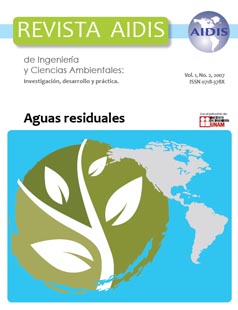Pré-tratamento de efluentes têxteis por processos oxidativos avançados visando maior eficiência do tratamento biológico posterior
Main Article Content
Abstract
Textile industry effluents have low biodegradability (BOD/COD ratio). An alternative to treat these effluents comprises advanced oxidative processes (AOPs) characterized by the use of a strong oxidant, the hydroxyl radical (•OH), to degrade organic matter. Photolysis and heterogeneous photolysis catalyzed by titanium dioxide are two processes that show great potential to treat textile industry effluents. Both processes receive the addition of hydrogen peroxide (H2O2/UV and H2O2/TiO2/UV). The complete treatment by AOPs is very expensive and, therefore, this work intended to assess a pretreatment by AOPs to increase the textile effluent biodegradability and improve its subsequent biological treatment. A preliminary test verified that the average oxidation state (relationship between COD and TOC) was stabilized and that the residual H2O2 was consumed after a two‐hour reaction, being unnecessary to extend the treatment beyond this period. Treatments with 2 mM of H2O2/UV and with only UV had few or no effect on the BOD, COD or biodegradabilility of the textile effluent. Treatments with 5 mM and 10mM of H2O2/UV presented the same trend, with increase of the effluent biodegradability during the first 30 minutes of treatment, but the increase of biodegradability by mg of H2O2 consumed was higher at the dose of 5 mM of H2O2 that at 10 mM of H2O2. COD removal in the treatments with H2O2/TiO2/UV was proportional to the increase of the peroxide dose applied, but the treatment with 5 mM of H2O2 provided an increased biodegradability (0.14 to 0.25), whereas the treatments with 0 e 2 mM of H2O2/TiO2/UV resulted in small BOD increases. Treatments with 5 mM of H2O2 with (H2O2/TiO2/UV) and without (H2O2/UV) titanium dioxide were selected as the best among the AOPs assessed. Both treatments were efficient to remove color from the textile effluent, accomplishing 64 to 66% of color removal during the first 60 minutes of reaction. However, the presence of the catalyst TiO2 did not result in higher effluent biodegradability. Based on these findings, the treatment H2O2/UV with 5 mM of H2O2 and a 30‐minute UV irradiation was considered the best alternative for the effluent studied.
Article Details
How to Cite
[1]
De Oliveira Pereira, R., Honor Mounteer, A., Corrêa Medeiros, R., Cunha Lopes, A., Brito Viana, D. and Latini Gomes, B. 2009. Pré-tratamento de efluentes têxteis por processos oxidativos avançados visando maior eficiência do tratamento biológico posterior. Revista AIDIS de ingeniería y ciencias ambientales: Investigación, desarrollo y práctica. 1, 2 (Nov. 2009).


